2012新版人教版七上英语全套教案
- 格式:doc
- 大小:791.50 KB
- 文档页数:63
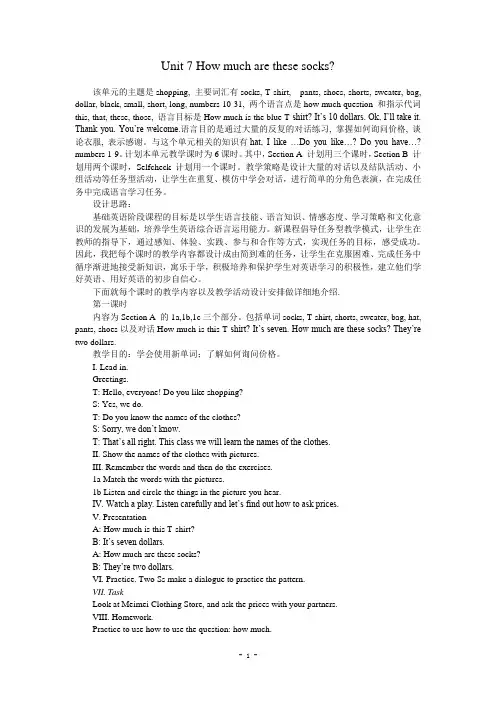
Unit 7 How much are these socks?该单元的主题是shopping, 主要词汇有socks, T-shirt, pants, shoes, shorts, sweater, bag, dollar, black, small, short, long, numbers 10-31, 两个语言点是how much question 和指示代词this, that, these, those, 语言目标是How much is the blue T-shirt? It’s 10 dollars. Ok, I’ll take it. Thank you. You’re welcome.语言目的是通过大量的反复的对话练习, 掌握如何询问价格, 谈论衣服, 表示感谢。
与这个单元相关的知识有hat, I like …Do you like…? Do you have…? numbers 1-9。
计划本单元教学课时为6课时。
其中,Section A 计划用三个课时,Section B 计划用两个课时,Selfcheck计划用一个课时。
教学策略是设计大量的对话以及结队活动、小组活动等任务型活动,让学生在重复、模仿中学会对话,进行简单的分角色表演,在完成任务中完成语言学习任务。
设计思路:基础英语阶段课程的目标是以学生语言技能、语言知识、情感态度、学习策略和文化意识的发展为基础,培养学生英语综合语言运用能力。
新课程倡导任务型教学模式,让学生在教师的指导下,通过感知、体验、实践、参与和合作等方式,实现任务的目标,感受成功。
因此,我把每个课时的教学内容都设计成由简到难的任务,让学生在克服困难、完成任务中循序渐进地接受新知识,寓乐于学,积极培养和保护学生对英语学习的积极性,建立他们学好英语、用好英语的初步自信心。
下面就每个课时的教学内容以及教学活动设计安排做详细地介绍.第一课时内容为Section A 的1a,1b,1c三个部分。
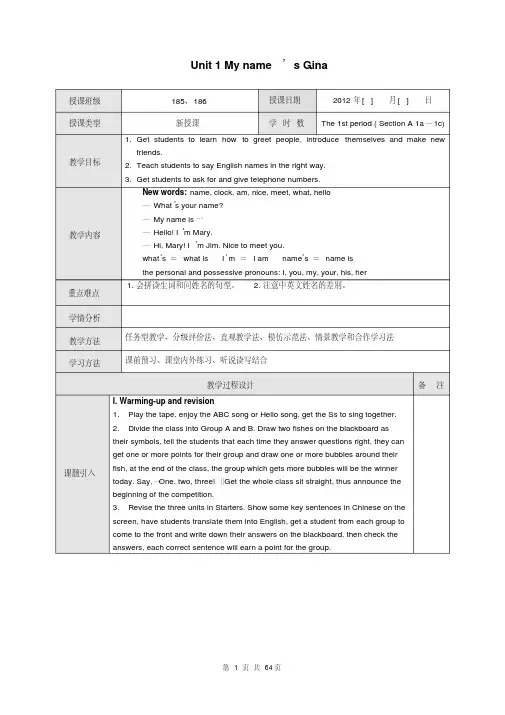
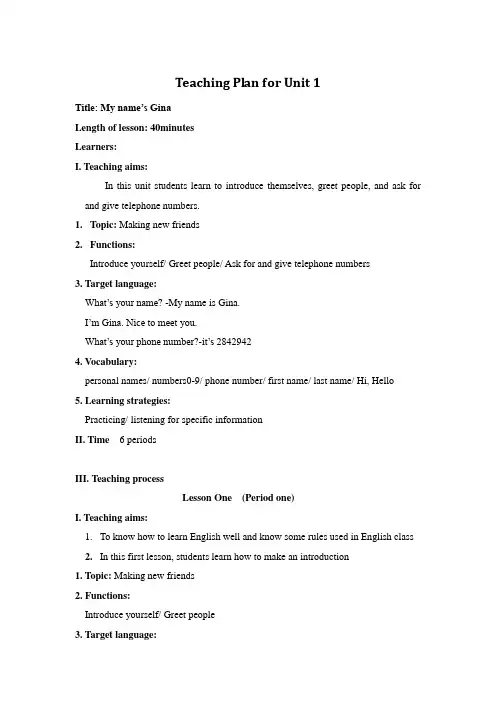
Teaching Plan for Unit 1Title: My name’s GinaLength of lesson: 40minutesLearners:I. Teaching aims:In this unit students learn to introduce themselves, greet people, and ask for and give telephone numbers.1. Topic: Making new friends2. Functions:Introduce yourself/ Greet people/ Ask for and give telephone numbers3. Target language:What’s your name? -My name is Gina.I’m Gina. Nice to meet you.What’s your phone number?-it’s 28429424. Vocabulary:personal names/ numbers0-9/ phone number/ first name/ last name/ Hi, Hello5. Learning strategies:Practicing/ listening for specific informationII. Time 6 periodsIII. Teaching processLesson One (Period one)I. Teaching aims:1. To know how to learn English well and know some rules used in English class2. In this first lesson, students learn how to make an introduction1. Topic: Making new friends2. Functions:Introduce yourself/ Greet people3. Target language:What’s your name?----My name’s… I’m …4. Vocabulary:Introduce/ Introduction/ name5. Learning strategies:Listening/ speaking/ singingIII. Teaching processStep I. Lead in -Greeting and making an introductionQuestion 1. Why do we study foreign language?2. How to study English well?Students’ feed back: discussing i n pairsStep II.making an introductionI’m Ms.Xu, your new English teacher, welcome to Ms. Xu’s English class. It’s verynice to see you. I’m sure we’re going to have a great year and learn a lot of English.giving some ways to learn English wellWe have many ways to learn English well. We can read, listen, speak and write. We can read books, listen to music “ABC”, “Apple song”, “London bridge is falling down”…. Moreover, we can speak in Engl ish. Listening is more important. If we don’t have a good listening, we cannot understand others well, and have a good communication. Writing is another way to improve our English.giving some rules used in English class1. Speak English as much as you can.2. Help each other.(help yourself with the dictionary)3. Ask questions when you do not understand.4. Don’t be shy.Step III.Now, let’s make an introduction1. Give an example:I’m Tracy, I mean my name is Tracy, and you can call me teacher Tracy.What’s your name, please? What’s his name? And what’s her name?2. Practice-in groups (3-4students)To practice the simple introduction with the following sentences:“What’s your/his/her name?----My/his/her name’s… or I’m …”3. Ask some group to show their introduction in the front of the classHomework: 1.to recite the words and expressions in starter2.to do some exercise in starterBlackboard design:The rules in English class:Introduction-to introduce yourself to othersWhat’s your/his/her name?-My/his/her name’s…Feed backUnit One (Period two)I. Teaching aims:In this lessen, the students will study how to introduce themselves with the following sentences “My name is…/ My first name is…/ My last name is…”1. Topic: Making new friends2. Functions:Introduce yourself/ Greet people3. Target language:What’s your name?/ What’s your first name?/ What’s your last name?4. Vocabulary:first name/ last name/ Hi/ Hello/ Nice to meet you5. Learning strategies:Listening/ speaking/ singingIII. Teaching processStep I. Lead inQuestion 1. What’s your name, please./ May I have your name, please?2.What’s your last name? / What’s your first name?3.If you want to show your politeness, what do you usually say when youfirst meet someone?Students’ feed back: discussing in pairsStep II. Learn and PracticeRecording for the first time. Students only listen. Focus attention on the example: the conversation numbered(1). Point out the boxes where students will write a number for each conversation. Play the recording a second time. Students number theconversations.Sec.A-2a: Play the recording for the first time. Students only listen. Point to theboxesnext to the pictures. (say: listen to the four conversations again. Write the number 1 inthebox next to the people who say conversation 1, 2 in the box next to the people whosayconversation2,etc.), 2b:Point the words in the box, (say: listen for these names in the conversations. You will hear some of the names, not all of them. circle the names you hear. The first one is done for you.)Do the exercise- Sec.B-3a: Read the list of names in theexercise.Ask students to guess which names are first names and which are last names. (Tell students your given name and your family name. Explain that, in English, your given name is referred to as your first name and your family name is referred to as your last name, or surname. The family name is written after one's given name, then point to individual students and say first name or last name, asking them to respond by saying their given name or family name.)Sec.A-3b: Ask the students to choose a first name and a last name that they like from3a.Game: This is a team game. The last student of each team isthe leader this time. I’ll ask a question to the first student like this. Then, the fi rst student answers my question and turns back to ask the second student the same question. Well, see. Just like this.Teacher: Hi, nice to meet you. I’m Tracy. Tracy is my first name and Xu is my last name. What’s your name?Student1: My name is Li Lei. (turn back to the next student) Nice to meet you, her name is Tracy Xu, and I’m Li Lei. My last name is Li and my firstname is Lei. What’s your name?Student2: Nice to meet you, too. My name is Liu Ying. (turn back to the next student) His name is Li Lei. And her name is Tracy Xu. I’ m Liu Ying.My last name is Liu and my first name is Ying. What’s your name?…At the end of the group, the leader who can tell the names as many as he can is winner.Culture note-English names vs. Chinese namesUnlike Chinese names, English names are listed with the given namefirstand the family name or surname second. Many people have two given names, e.g.SaraAnn Smith. The second name is called the middle name and has no real significance, unlike the Chinese second name which indicates a child’s generation. English family names are inherited from the father, and a woman’s family name changes to the familyname of her husband when she marries. Chinese women do not necessarily take their husband’s family name when they marry. Many English names have and old meaning,but the meaning is not usually a consideration when choosing a name, the way the namesounds is more important. In Chinese culture, naming a child often takes five principlesinto consideration: the name should reflect favorable mathematical calculations, be harmonious with regard to yin and yang, and possess one of the five elements of metal,water, wood, fire, and air.“The More We Get Together”The more we get together, together, together, the more we get together, the happierwe’ll be! For your friends are my friends and my friends are your friends, the more we get together, the happier we’ll be!Step III. ProductionTask one: It’s warmi ng up, the students think the questions that teacher gives and step in the situation-“Greeting” and “Introduction”.Task two: Do exercise and practice in book. Moreover, learn how to ask names.Task three: Practice the greeting “nice to meet you”, introduc tion and the first name, last name.Task four: RelaxingStep IV. Sum up1. the whole class practice how to greet people and introduce each other.2. learn the difference between Chinese culture and western culture.3. Learn a beautiful English song.Homework: 1.Sing two songs2.Review the starter and do some exercise:P1 Sec.A-1a; P4 Sec.B-1a,2;P6-1; P7 Sec.A-1a; P10 SecB-1a; P11-3a; P12-1; P13 Sec.A-1a; P18-1; P19- 1a; P24-1; P25 SecA-1a; P30-1,2,3.3.Review the Grammar Focus in StarterBlackboard design:First name What’s your name? My name is…Last name May I have your name? I’m….My first name is…/ My last name is…Nice/glad/great/lovely to meet/see you!Feed backUnit One (Period three)I. Teaching aims:This lesson introduces the numbers0-9, and practices the telephone number in random order.1. Topic: Getting the telephone number2. Functions:Ask for and give telephone numbers.3. Target language:What’s your/his/her telephone number?4. Vocabulary:telephone number/one two three four five six seven eight nine5. Learning strategies:Listening/ speaking/ singing/ writingIII. Teaching processStep I. Lead inQuestion 1. We have already made a new friend and knew his or her name but if we want to communicate him or her what will we do?2. How to ask and give telephone number?Students’ feed back:Step II. PracticeSec.B-1a: Play the recording for the first time. Students onlylisten. As the teacher plays the recording the second time, ask students to repeat the numbers.Sec.B-1b: Play the recording for the first time. Students only listen. Point out the telephone number in activity 1c. ask students how the number is divided up. Guide them to understand that three or four numbers come before the hyphen and four numbers after it. (6218-8020). Ask students to write the numbers in the blank as you play the recording the second time.Sec.B-2a:Point to the numbered list of names. Read each one aloud along with the number that comes before it. Point to the blanks in the four telephone numbers.(Say, I will play the recording twice. the first time just listen. The second time, write the letter of the person's telephone number in the space after that person's name.)Play the recording while students listen. Play the recording a second time.(This time students write the letter of each telephone number in the bland after the person's name).Check the answers.Ten little Indian boys"One little, two little, three little Indians, four little, five little, six little Indians, seven little, eight little, nine little Indians, ten little Indian boys.Ten little, nine little, eight little Indians, seven little, six little, five little Indians, four little, three little, two little Indians, one little Indian boy.One little, two little, three little fingers, four little, five little, six little fingers, seven little, eight little, nine little fingers, ten fingers on your hands.Ten little, nine little, eight little fingers, seven little, six little, five little fingers, four little, three little, two little fingers, one finger on your hand.Step III. ProductionTask one: listen and repeat the numbersTask two: listen the conversation and get the useful information-numbersTask three: get the knowledge of last name and first name.Task four: relax and know the numbers well.Homework: design your name cardTracy XuMaster teacher of Class 3, Junior 1The Middle School Attached to Northern Jiaotong UniversityTel:010-6218-6020Address: No.12 Zhaojunmiao,Haidian District, BeijingPostcode:100081Blackboard design:What's your telephone number?----My telephone number is...zero, one, two, three, four, five, six, seven, eight, nineFeed backUnit One (Period four)I. Teaching aims:This lesson reviews the numbers0-9, and practices the telephone number in random order.1. Topic: Getting the telephone number2. Functions:Ask for and give telephone numbers.3. Target language:What’s your/his/her telephone number?--my/his/her telephone number is.../It's... 4. Vocabulary:telephone number/one two three four five six seven eight nine5. Learning strategies:Listening/ speaking/ writingIII. Teaching processStep I. Lead inQuestion 1. Review the song "Ten little Indian boys"2. How to get somebody's telephone number? And what do we say?3. How about to make a phone book of our class?Students’ feed back:Step II. PracticeActivity one (task one): Sing the song "Ten little Indian boys"Activity two (task two): Make a telephone number book.In order to communicate better, today we are going to make our own phone book. I'll give you two minutes. Group leaders, try to find out your partners' telephone numbers and then fill in the chart. After that, hand in your charts to your group leader. At last, the leaders will stand up and tell the whole class the telephone numbers of your group. Everyone in class should follow him and write down the names and numbers.Step III. ProductionTask one:Task two: Make a telephone book of the whole classmatesHomework: design the Personal information card (including name (last name and first name), telephone number and other information)Blackboard design:Feed back: The activity two provides an opportunity for oral practice using the target language, and practices the listening and writing numbers. Moreover, the students have the telephone numbers of the whole class that will tie them closely.Unit One (Period five) (Sep.11th-the mid-autumn festival) I. Teaching aims:know the culture of the mid-autumn festival (15th day of the 8th lunar month); classify the fruit; check the exercise P32-2breview the Grammar focus of unit one;1. Topic: The Mid-autumn Festival2. Functions:classification3. Target language:I you he she it we you theyMy your his her its our your their4. Vocabulary:fruit/ stationery/ color/ drink/ Verb5. Learning strategies:classifyingIII. Teaching processStep I. Lead inQuestion 1. What date is today?2. What does the mid-autumn festival mean to Chinese?3. What do we do usually in this festival?Students’ feed back:Step II. Practiceintroduce the traditional festival of Chinese----"the mid-autumn festival"discuss the activities the Chinese people usually do in this festival--the food, the activities...goodsStep III. ProductionTask one:Task two:Task three:Fruit: apple, pear, orange, grapes, kiwi fruit, lemon, pineapple, mango, banana, plum, apricot, peach...Stationery: bag, book, pen, pencil, ruler, rubber, pencil case…Color: black, red, white, orange, green, blue, yellow, violet, purple…Drink: mil k, cola, orange juice, soda, mineral water, wine, beer…Verb: listen, look, write, (map, phone), run, jump, speak, smell…Homework:1.Do exercise--P32 and exercise P1-1 in yellow book, and give more words in each column2."face to face with the famous person" (find some information of a famous person that you like. Such as: pictures, work place, hobbies and so on)Blackboard design:Feed back: give more knowledge of the Chinese traditional festival and learn Chinese culture; learn how to classify the goodsUnit One (Period six)I. Teaching aims:review unit 1 and have self check1. Topic: having a review of the first unit2. Functions:ask name and telephone number3. Target language:4. Vocabulary:clock, fire extinguisher, basketball, necklace, trash, door knob, tie, tank of goldfish, skirt, sportswear, sneaker...5. Learning strategies: reading/ speakingIII. Teaching processStep I: Show the ID cards and the information about the famous people the students have already collected and encourage students.and speak out the information except the name, ask the students to write down some information and to guess the ID card's owner---- "What's her/his name?”,” What’s his/her telephone number?"much. "what's his/her name?" "Why do you like him/her so much?"Step II: Self checkP6-1. 2. Ask students to check all the words they know and ask them to find out the meanings of any words they don’t know.P6-3. Ask students to think of two classmates, a boy and a girl. Have them write their classmates’ details in the charts.“Just for Fun!”Try to tell a story according to the picture.Student’s work:“A red ‘Z’ hid beside the gray wall while a green ‘Z’ was walking alone, suddenly, the red one jumped out and shouted ‘past’. The green one was frightened and asked in a trembling voice ‘What’s your first name? The red one said, ‘ZIG’, and the red one asked, ‘What’s your last name?’. The green one said ‘ZAG’.”Give a quiz for Unit 1in workbookHomework:1.Review Unit 12.Make a preparation before studying Unit 2 (words and expressions)。
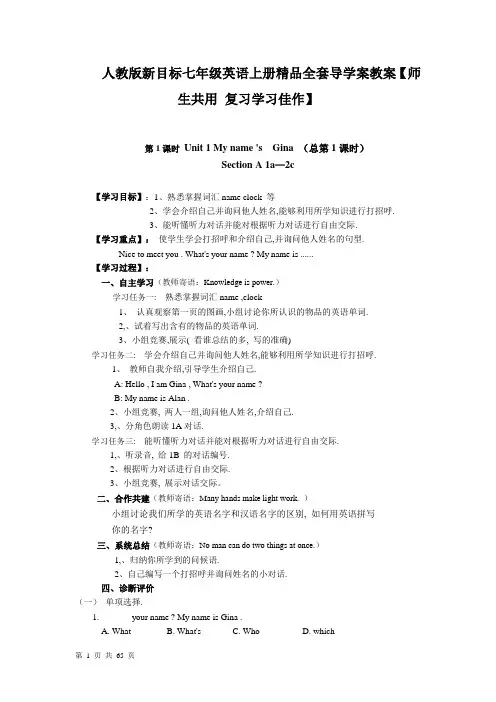
人教版新目标七年级英语上册精品全套导学案教案【师生共用复习学习佳作】第1课时Unit 1 My name 's Gina (总第1课时)Section A 1a—2c【学习目标】:1、熟悉掌握词汇name clock 等2、学会介绍自己并询问他人姓名,能够利用所学知识进行打招呼.3、能听懂听力对话并能对根据听力对话进行自由交际.【学习重点】:使学生学会打招呼和介绍自己,并询问他人姓名的句型.Nice to meet you . What's your name ? My name is ......【学习过程】:一、自主学习(教师寄语:Knowledge is power.)学习任务一: 熟悉掌握词汇name ,clock1、认真观察第一页的图画,小组讨论你所认识的物品的英语单词.2,、试着写出含有的物品的英语单词.3、小组竞赛,展示( 看谁总结的多, 写的准确)学习任务二: 学会介绍自己并询问他人姓名,能够利用所学知识进行打招呼.1、教师自我介绍,引导学生介绍自己.A: Hello , I am Gina , What's your name ?B: My name is Alan .2、小组竞赛, 两人一组,询问他人姓名,介绍自己.3,、分角色朗读1A对话.学习任务三: 能听懂听力对话并能对根据听力对话进行自由交际.1,、听录音, 给1B 的对话编号.2、根据听力对话进行自由交际.3、小组竞赛, 展示对话交际。
二、合作共建(教师寄语:Many hands make light work. )小组讨论我们所学的英语名字和汉语名字的区别, 如何用英语拼写你的名字?三、系统总结(教师寄语:No man can do two things at once.)1,、归纳你所学到的问候语.2、自己编写一个打招呼并询问姓名的小对话.四、诊断评价(一)单项选择.1. _______your name ? My name is Gina .A. WhatB. What'sC. WhoD. which2. Good morning , Miss Wang ! _____________!A. HelloB.HiC. Nice to meet youD. Good morning3. I _______Sally , What______ your name ?A. am ,isB. is , amC. is , isD.am, am4. ______name is Li lei .A. IB. I amC. MyD. you5.—_______, What's your name ?—John Green .A. HiB. OkC. sorryD. Excuse me(二)写出下列单词的完全形式, 并写出汉语意思.I'm _________ __________ what's __________ ________name 's ___________ __________(三)写出下列单词.时钟_______ 我的________ 你的___________ 名字_______ 遇见_________ (四)尝试翻译下列句子.1. 见到你很高兴. _________________________________.2.我叫王小雨. ____________________________________.3. 你叫什么名字? ____________________________________(五)根据情景补全对话.A: Good afternoon !____________________!A; I ______Lucy . _________your name ?B: My ______ is Jim . Nice to ______you !A: _______________________________.五、【课后反思】(教师寄语:Never do things by halves)第2课时Unit 1 My name 's Gina.(总第2课时)Section A (1a—2c)【学习目标】:1、熟练掌握本课6个单词.2、学会询问他人姓名及介绍他人姓名.3、能听懂有关谈论他人姓名的对话并进行自由交际.【学习重点】:询问他人姓名及介绍他人姓名的句型.一、自主学习(教师寄语:Knowledge is power.)学习任务一: 熟练读写本课6个单词.1.个人自渎,记忆本课单词.2.小组互相检查单词读写情况.3.根据汉语写出下列英语单词并展示.学习任务二: 运用句型:What's his / her name?His / Her name is .... 进行自由交际.1.小组合作,理解并熟读下列短语,并写出汉语意思.my nane ( ) your name ( )his name ( ) her name ( )2.个人理解下列对话,并且两人合作练习.A:Hello! What's your name?B:My name is Gina.A:Nice to meet you.B:Nice to meet you,too.A:What's her name?B:Her name is Jenny.3.小组合作,练习自己的对话.4. 对抗组开展竞赛,展示自己的对话.学习任务三: 听听力完成2a,2b.1.个人看图,理解四幅图画,思考图画中人是在谈论他人还是对方.2.听听力,给四幅图画编号.3. 小组为单位,熟读2b中的名字。
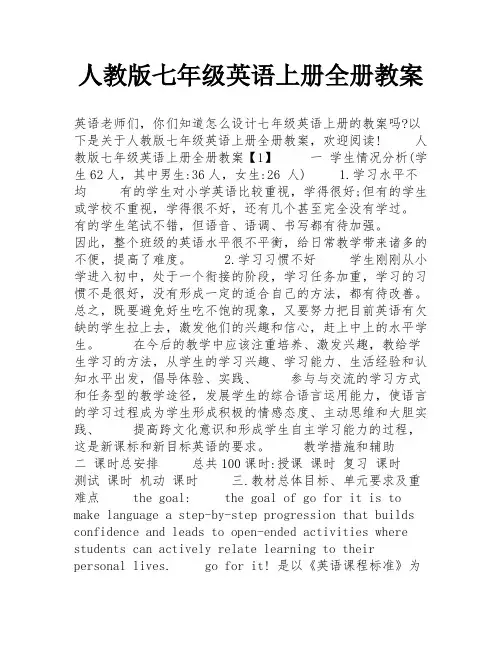
人教版七年级英语上册全册教案英语老师们,你们知道怎么设计七年级英语上册的教案吗?以下是关于人教版七年级英语上册全册教案,欢迎阅读! 人教版七年级英语上册全册教案【1】一学生情况分析(学生62人,其中男生:36人,女生:26 人) 1.学习水平不均有的学生对小学英语比较重视,学得很好;但有的学生或学校不重视,学得很不好,还有几个甚至完全没有学过。
有的学生笔试不错,但语音、语调、书写都有待加强。
因此,整个班级的英语水平很不平衡,给日常教学带来诸多的不便,提高了难度。
2.学习习惯不好学生刚刚从小学进入初中,处于一个衔接的阶段,学习任务加重,学习的习惯不是很好,没有形成一定的适合自己的方法,都有待改善。
总之,既要避免好生吃不饱的现象,又要努力把目前英语有欠缺的学生拉上去,激发他们的兴趣和信心,赶上中上的水平学生。
在今后的教学中应该注重培养、激发兴趣,教给学生学习的方法,从学生的学习兴趣、学习能力、生活经验和认知水平出发,倡导体验、实践、参与与交流的学习方式和任务型的教学途径,发展学生的综合语言运用能力,使语言的学习过程成为学生形成积极的情感态度、主动思维和大胆实践、提高跨文化意识和形成学生自主学习能力的过程,这是新课标和新目标英语的要求。
教学措施和辅助二课时总安排总共100课时:授课课时复习课时测试课时机动课时三.教材总体目标、单元要求及重难点the goal: the goal of go for it is to make language a step-by-step progression that builds confidence and leads to open-ended activities where students can actively relate learning to their personal lives. go for it! 是以《英语课程标准》为依据,以学生的英语语言综合运用能力为目标。
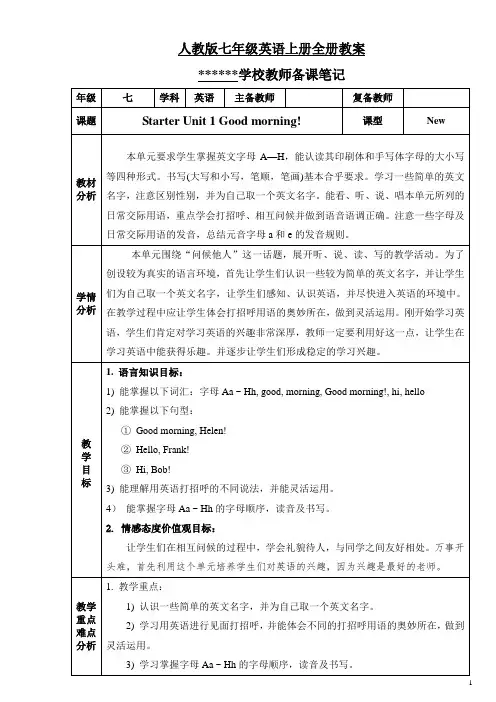
人教版七年级英语上册全册教案******学校教师备课笔记学校教师备课笔记Revise some school things byasking questions. e.g.: What ’s this? Is this a …? How do you spell it?etc.Learn the new words in, on, under, behind … by helping the teacher find the lost things. e.g.: T: Where ’s my English book? S1: It ’s here. / I think it ’s …T: Oh, it ’s on the desk. … T: Where ’re my color pencils? S2: … Teach the new word “where ” and the use of “they ”. Consolidate the prepositions by looking at thescreen and answer thequestions: Where ’s … ?Where ’re …?Hide and look for thingsShow the students a picture of a room, tell them this is a bedroom, let the students list the things in it first. Then show them the whole picture, teach the new words, ask where the things are, let the students answer, using the prepositions.Repeat with a sitting room and a study, teach the new words and practice in the same way.Section A, 1a: Match the words with the things in the picture. Students do it individually first, then check the answers. Section A, 1c: Make up dialogues in pairs, using the things in the picture.Chatting. Chat with the students about the things around the room by showing them pictures. Ask the students to spell the new words. Section A, 2a. Revise what the things are. Play the tape for students and let them number them. Section A, 2b. Play the tape again, students number the things [1-6] in the picture. Imitate the dialoguesSection A, 2c. Look at the picture in 2b again. Students use general questions to ask and answer about the things in it.Ask some students to report their answer like this: In Picture 1, the pencil case is …In Picture 2, the pencil case is…; In Picture 1, the books are …In Picture 2, the books are …Present short dialogues, using pictures or objects to help. Dialogue 1: A: Where’s my bag? B: I don’t know. Is it on the sofa? A: No, it isn’t. Dialogue 2: A: Where’re my books? B: I don’t know. Are they on the bed? A: Yes, they are. Teach “don’t =do not”, “know”. Check the homework in Period One. Make reports to share the information they got from the friends or teachers, and give their simply assessment.Let the students makesimilar dialogues according to the pictures in Section A, 3a&3c. Put the dialogue in the right order.( Section A, 3a.) Listen and imitate the dialogues in Section A, 1b.answer make similar dialogues according to the pictures in Section A, 3a&3c.Ask some pairs to act out the dialogues in Section A, 2a & 2b. Show the students a picture of a room. Let the students say likethis: The ID card is on the table. The books are on the chair. Let some able students list some new words. Practice reading them. Match the new words with the things in thepicture. (Section B, 2a.) Pairwork. Talk about the picture.( Section B, 1b&1c.)Play the tape twice for students to listen and circle the things Tommy wants from his room. Check the answers. ( Section B, 2a. )Listen again.Show a picture of a roomwith a few things in it, give the students a short note about the things around the room to read, let the students try to find out thedifferences between the reading material and the picture. Circle the mistakesin the reading material. Make an orally report by looking at the picture again. The students read the note silently and draw the missing things in the picture. ( Section B, 3a.) (为了节省时间,教师可以让学生在图中标出数字来替代画图。

人教版七年级英语上册全册教案******学校教师备课笔记学校教师备课笔记Revise some school things byasking questions. e.g.: What ’s this? Is this a …? How do you spell it?etc.Learn the new words in, on, under, behind … by helping the teacher find the lost things. e.g.: T: Where ’s my English book? S1: It ’s here. / I think it ’s …T: Oh, it ’s on the desk. … T: Where ’re my color pencils? S2: … Teach the new word “where ” and the use of “they ”. Consolidate the prepositions by looking at thescreen and answer thequestions: Where ’s … ?Where ’re …?Hide and look for thingsShow the students a picture of a room, tell them this is a bedroom, let the students list the things in it first. Then show them the whole picture, teach the new words, ask where the things are, let the students answer, using the prepositions.Repeat with a sitting room and a study, teach the new words and practice in the same way.Section A, 1a: Match the words with the things in the picture. Students do it individually first, then check the answers. Section A, 1c: Make up dialogues in pairs, using the things in the picture.Chatting. Chat with the students about the things around the room by showing them pictures. Ask the students to spell the new words. Section A, 2a. Revise what the things are. Play the tape for students and let them number them. Section A, 2b. Play the tape again, students number the things [1-6] in the picture. Imitate the dialoguesSection A, 2c. Look at the picture in 2b again. Students use general questions to ask and answer about the things in it.Ask some students to report their answer like this: In Picture 1, the pencil case is …In Picture 2, the pencil case is…; In Picture 1, the books are …In Picture 2, the books are …Present short dialogues, using pictures or objects to help. Dialogue 1: A: Where’s my bag? B: I don’t know. Is it on the sofa? A: No, it isn’t. Dialogue 2: A: Where’re my books? B: I don’t know. Are they on the bed? A: Yes, they are. Teach “don’t =do not”, “know”. Check the homework in Period One. Make reports to share the information they got from the friends or teachers, and give their simply assessment.Let the students makesimilar dialogues according to the pictures in Section A, 3a&3c. Put the dialogue in the right order.( Section A, 3a.) Listen and imitate the dialogues in Section A, 1b.answer make similar dialogues according to the pictures in Section A, 3a&3c.Ask some pairs to act out the dialogues in Section A, 2a & 2b. Show the students a picture of a room. Let the students say likethis: The ID card is on the table. The books are on the chair. Let some able students list some new words. Practice reading them. Match the new words with the things in thepicture. (Section B, 2a.) Pairwork. Talk about the picture.( Section B, 1b&1c.)Play the tape twice for students to listen and circle the things Tommy wants from his room. Check the answers. ( Section B, 2a. )Listen again.Show a picture of a roomwith a few things in it, give the students a short note about the things around the room to read, let the students try to find out thedifferences between the reading material and the picture. Circle the mistakesin the reading material. Make an orally report by looking at the picture again. The students read the note silently and draw the missing things in the picture. ( Section B, 3a.) (为了节省时间,教师可以让学生在图中标出数字来替代画图。

人教版7上英语教案5篇(实用版)编制人:__审核人:__审批人:__编制单位:__编制时间:__年__月__日序言下载提示:该文档是本店铺精心编制而成的,希望大家下载后,能够帮助大家解决实际问题。
文档下载后可定制修改,请根据实际需要进行调整和使用,谢谢!并且,本店铺为大家提供各种类型的实用资料,如工作计划、汇报材料、心得体会、发言稿、合同大全、申请书、演讲稿、作文大全、教案大全、其他资料等等,想了解不同资料格式和写法,敬请关注!Download tips: This document is carefully compiled by this editor.I hope that after you download it, it can help you solve practical problems. The document can be customized and modified after downloading, please adjust and use it according to actual needs, thank you!Moreover, our store provides various types of practical materials for everyone, such as work plans, presentation materials, reflections, speech drafts, contract summaries, application forms, speech drafts, essay summaries, lesson plans, and other materials. If you want to learn about different data formats and writing methods, please stay tuned!人教版7上英语教案5篇教案的实施需要教师具备良好的组织和管理能力,以确保教学过程的顺利进行,编写详细的教案可以帮助我们更好地运用各种教学方法和策略,提高教学的多样性,以下是本店铺精心为您推荐的人教版7上英语教案5篇,供大家参考。
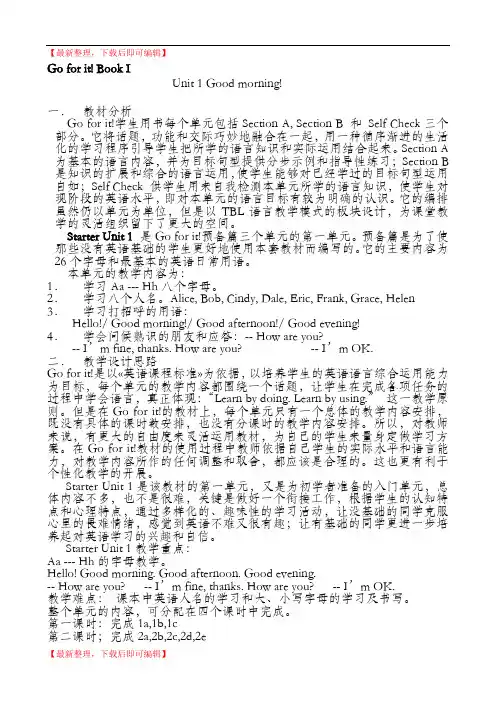
【最新整理,下载后即可编辑】Go for it! Book IUnit 1 Good morning!一.教材分析Go for it!学生用书每个单元包括Section A, Section B 和Self Check三个部分。
它将话题,功能和交际巧妙地融合在一起,用一种循序渐进的生活化的学习程序引导学生把所学的语言知识和实际运用结合起来。
Section A 为基本的语言内容,并为目标句型提供分步示例和指导性练习;Section B 是知识的扩展和综合的语言运用,使学生能够对已经学过的目标句型运用自如;Self Check 供学生用来自我检测本单元所学的语言知识,使学生对现阶段的英语水平,即对本单元的语言目标有较为明确的认识。
它的编排虽然仍以单元为单位,但是以TBL语言教学模式的板块设计,为课堂教学的灵活组织留下了更大的空间。
Starter Unit 1是Go for it!预备篇三个单元的第一单元。
预备篇是为了使那些没有英语基础的学生更好地使用本套教材而编写的。
它的主要内容为26个字母和最基本的英语日常用语。
本单元的教学内容为:1.学习Aa --- Hh八个字母。
2.学习八个人名。
Alice, Bob, Cindy, Dale, Eric, Frank, Grace, Helen 3.学习打招呼的用语:Hello!/ Good morning!/ Good afternoon!/ Good evening!4.学会问候熟识的朋友和应答:-- How are you?-- I’m fine, thanks. How are you? -- I’m OK.二.教学设计思路Go for it!是以«英语课程标准»为依据,以培养学生的英语语言综合运用能力为目标,每个单元的教学内容都围绕一个话题,让学生在完成各项任务的过程中学会语言,真正体现:“Learn by doing. Learn by using.”这一教学原则。
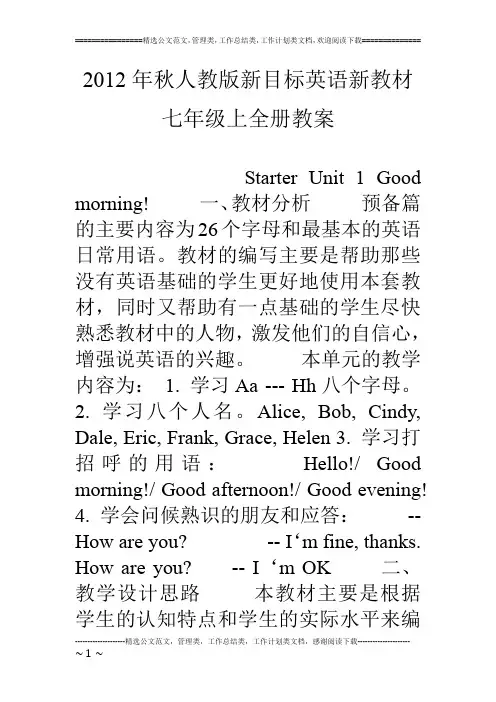
2012年秋人教版新目标英语新教材七年级上全册教案Starter Unit 1 Good morning! 一、教材分析预备篇的主要内容为26个字母和最基本的英语日常用语。
教材的编写主要是帮助那些没有英语基础的学生更好地使用本套教材,同时又帮助有一点基础的学生尽快熟悉教材中的人物,激发他们的自信心,增强说英语的兴趣。
本单元的教学内容为: 1. 学习Aa --- Hh八个字母。
2. 学习八个人名。
Alice, Bob, Cindy, Dale, Eric, Frank, Grace, Helen3. 学习打招呼的用语:Hello!/ Good morning!/ Good afternoon!/ Good evening!4. 学会问候熟识的朋友和应答:-- How are you?-- I‘m fine, thanks. How are you?-- I‘m OK 二、教学设计思路本教材主要是根据学生的认知特点和学生的实际水平来编写的,不仅帮助学生学会一些语言基础知识,更重要的是培养和发展学生的语言运用能力。
每个单元都围绕一个中心话题来设计不同的任务,让学生通过“Learn by doing. Learn by using.”来完成。
对教师来说,有更大的自度来灵活运用教材,为自己的学生来量身定做学习方案。
本单元是为初学者准备的入门单元,总体内容不多,也不是很难,关键是做好一个衔接工作,根据学生的认知特点和心理特点,通过多样化的、趣味性的学习活动,让没基础的同学克服心里的畏难情绪,感觉到英语不难又很有趣;让有基础的同学更进一步培养起对英语学习的兴趣和自信。
三、教学重点 1. 认识教材中的人物,熟悉八个名字。
2. 字母Aa --- Hh的教学。
3. 打招呼的用语:Hello! Good morning. Good afternoon. Good evening. -- How are you? -- I‘m fine, thanks. How are you? -- I‘m OK.4. 字母a,e在开音节和闭音节中的读音规则。
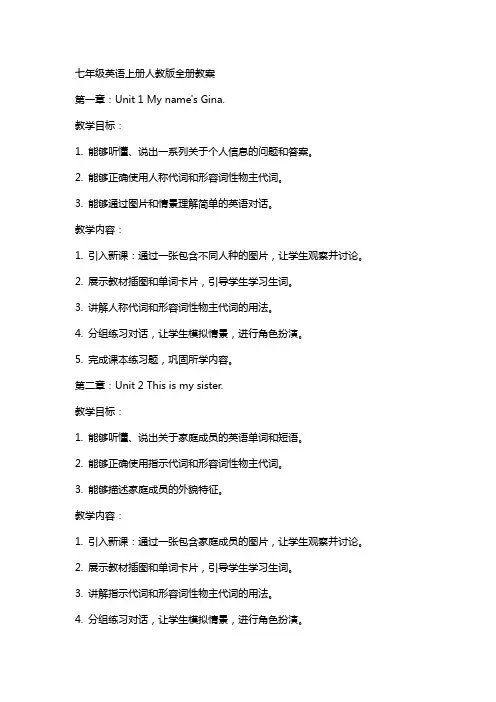
七年级英语上册人教版全册教案第一章:Unit 1 My name's Gina.教学目标:1. 能够听懂、说出一系列关于个人信息的问题和答案。
2. 能够正确使用人称代词和形容词性物主代词。
3. 能够通过图片和情景理解简单的英语对话。
教学内容:1. 引入新课:通过一张包含不同人种的图片,让学生观察并讨论。
2. 展示教材插图和单词卡片,引导学生学习生词。
3. 讲解人称代词和形容词性物主代词的用法。
4. 分组练习对话,让学生模拟情景,进行角色扮演。
5. 完成课本练习题,巩固所学内容。
第二章:Unit 2 This is my sister.教学目标:1. 能够听懂、说出关于家庭成员的英语单词和短语。
2. 能够正确使用指示代词和形容词性物主代词。
3. 能够描述家庭成员的外貌特征。
教学内容:1. 引入新课:通过一张包含家庭成员的图片,让学生观察并讨论。
2. 展示教材插图和单词卡片,引导学生学习生词。
3. 讲解指示代词和形容词性物主代词的用法。
4. 分组练习对话,让学生模拟情景,进行角色扮演。
第三章:Unit 3 Please open the window.教学目标:1. 能够听懂、说出关于日常生活中的祈使句。
2. 能够正确使用动词短语。
3. 能够根据情景进行简单的交际。
教学内容:1. 引入新课:通过一个日常生活中的场景,让学生观察并讨论。
2. 展示教材插图和单词卡片,引导学生学习生词。
3. 讲解祈使句的用法和动词短语的构成。
4. 分组练习对话,让学生模拟情景,进行角色扮演。
5. 完成课本练习题,巩固所学内容。
第四章:Unit 4 Is this your schoolbag?教学目标:1. 能够听懂、说出关于物品所有格的英语单词和短语。
2. 能够正确使用一般疑问句和回答。
3. 能够描述物品的特征。
教学内容:1. 引入新课:通过一张包含不同物品的图片,让学生观察并讨论。
2. 展示教材插图和单词卡片,引导学生学习生词。
新人教版七年级英语上册全册教案Starter Unit 1 Good morning.1. Good morning/afternoon/evening. 早上(上午)/下午/晚上好。
答语相同。
在熟人或家人之间可省略good。
熟人之间的问候可加上称呼语,称呼语放在问候语之后且用逗号隔开。
如:Good morning , class!同学们,早上好!△Good night!晚安(晚间告别用语)2. Hello, Frank! 你好,弗兰克。
3. A: How are you? 你(身体)好吗?B: (I’m) fine/Very well/I’m OK, Thank you./thanks. How are you? / And you? 我很好,谢谢。
你呢?A: (I’m)fine/OK, too.我也很好。
4. thanks = thank you 谢谢5. HB(铅笔芯)硬黑CD光盘BBC英国广播公司Starter Unit 2 What’s this in English?1.What’s this/that? 这/那是什么?It’s a/an + 单数物品(△不说This/That is...)1) What’s this/that? 这/那是什么?2) What’s this/that? 这/那是什么?It’s a ruler. (这/那是)直尺。
It’s an apple. (这/那是)苹果。
2.What’s this/that in English? 这/那用英语怎么说?It’s a/an + 单数物品(△不说This/That is...)What’s this in English? 这用英语怎么说?It’s a jacket. 夹克衫What’s that in English? 那用英语怎么说?It’s an orange. 橘子。
in + 语言:用某种语言in Chinese/English/Japanese用汉/英/日语英语中还可用What’s the English for….?表达同样的含义。
新人教版七年级英语上册全册教案写教案是提高教学水平的重要过程。
下面是为大家精心整理的新人教版七年级英语上册全册教案,仅供参考。
新人教版七年级英语上册全册教案(一) Starter U1 Good Morning1. Names: 姓名与性别英语人名中带有性别特征。
从姓名基本可以看出性别。
2. Greet people1) Good morning/ afternoon/ evening(见面)问候语但Good night(晚安,再见)2) A: Nice to meet you. B: Nice to meet you, too.3)A: How are you? B: I m fine/ ok. Thanks.4) Hello, Hi3. Letters: A-H (书写,发音)4. 字母A,E在单词中的发音及含有相应发音的字母(P S4)字母A在单词中的发音[ei], [ ] 及含[ei]音的字母(A, H, J, K,)字母E在单词中的发音[i:], [e],及含[i:]音的字母(B, C, D, E, G, P, T, V, Z) ;含[e]音的字母(F, L,M, N, S,X,Z)新人教版七年级英语上册全册教案(二) Starter U2 What s this in English?1.介绍身边事物及中英文拼写Eg 1) A: What s this in English?B: It s a schoolbag.A: Spell it, please. (How to spell it?)B:s-c-h-o-o-l-b-a-gEg 2) A: What s this in English?B: It s an orange.A: Spell it, please. (How to spell it?)B:o-r-a-n-g-eEg 3) A: What s that in English?B: It s a jacket.A: Spell it, please. (How to spell it?)B: J-A-C-K-E-T.补充:1) in表示用(语言) 。
七年级英语上册人教版全册教案一、第一单元:My name's Gina,my name's L cy1. 教学目标:了解并掌握自我介绍的常用句型,如“My name's”和“I'm from”。
能够正确书写自己的姓名和来自的地方。
学会使用问候语与人打招呼。
2. 教学内容:单词:name, I'm, from, where, am, class, grade, school, in, my 句型:1. My name's 2. I'm from对话:1. A: My name's Gina. B: Nice to meet you, Gina.2. A: I'm from Beijing. B: Oh, really? I'm from Shangh.3. 教学步骤:1) 热身活动:让学生自由交谈,互相问候。
2) 引入新课:展示图片,引导学生说出自己和他的家乡。
3) 讲解单词和句型:讲解单词和句型的用法。
4) 练习对话:让学生分角色扮演,进行对话练习。
5) 总结:检查学生的学习效果,进行反馈。
二、第二单元:What's your name?1. 教学目标:掌握询问别人姓名的常用句型“What's your name?”和回答“My name's”。
学会介绍自己的年龄和年级。
2. 教学内容:单词:hello, nice, to, you, what, name, is, my, how, old, are, you, in, grade句型:1. What's your name? 2. My name's 3. How old are you? 4. I'm in grade.对话:1. A: Hello, nice to meet you. B: Hello, nice to meet you, too.2. A: What's your name? B: My name's Tom.3. 教学步骤:1) 热身活动:让学生自由交谈,互相问候。
2012年七年级英语上册全册教案dule1lassatesUnit1Nieteetu课型Listeningandspeaing教材分析ThisisthefirstlessninthisduleTheaintpiisself-intrdutin,sipr vingthestudents’abilitiesflisteningandspeaingnself-intrdutinsisveriprtant 知识目标evabular:hinese,fr,here,ear,abut,hatabut…?s,Aeria,nt,England,hi,Aerian,ur,grade,he,hinaestrutures:Hell/Hihat'surnae?naeisHldareu?I'earsldhereareufr?I'frNieteetuNieteetu,t能力目标Tunderstandnversatinsinvlvingself-intrdutin2Tgiveabriefself-intrdutinnerningnae,ageandhetn 情感态度LearntrespetthershenetaliththersLearntintrdueurselfturfriendsintherighta 教学方法Interativeapprah教具Tapererder,ultiedia教学过程Step1:aringupTheteahershthePPTandplaashrtflash,thestudentsenthesng 2Plaaguessinggae"Brainstr"basingthestudents"hat'sit?" ThenshtheusefulsentenesbintrduingselfIaLiFangIafruhanIahineseIa25earsldIaurneteaher3Asthestudentstintrduetheselvesingrupsbusingthesesentenes: hat'surnae?hereareufr?Hldareu?hihlassareuin?NieteetuStep2:ListeningPlathererdinginativit1andasthestudentstlistenandhehanpeplespea2Plaitagainandasthestudentsthetherdstheirhear3hetheansersiththehlestudentsStep3:ListenandreadPlathererdinginativit3andasthestudentstlistenandanserthequestinsThenhetheansersHanpeplespeainthenversatin?harethe?Aretheinthesaelass?2Plaitagainandhethetruesentenesinat3Assestudentstrrettherngnes3PutthestudentsintgrupsffurtpratisethedialgueThestudentsrepeatitseveralties,hangingrleseahtie4TalabutthepituresinthePPTandshtheirperfranes5Asthestudentstsuuptheusefulsentenesinthedialgueandintrdue “EverdaEnglish”6Finishat4and5ingrupsTeaherhestheansersStep4:PrnuniatinExplainthatthisativitfusesnseEnglishphneeshiharediffiulttpr nunefrspeaersfhinese2Plathererdingneithutstpping3Plaitagainandasthestudentstrepeat4Pratisethesundsinpairs,thenfinishtheexerisesnthePPTStep5:SpeaingTalabutthepituresbasingandanserinparisliethis:A:hat’shisnae?B:Hisnaeis…A:hereishefr?B:He'sfr…A:Hldishe?B:He'searsldStep6:duletasTas1:hhasthestfriends?运用本课句型,在规定的八分钟时间内,以小组为单位,看谁结交的朋友最多,她将获得一份丰厚的奖品。
Period One教学目标:1. 学会打招呼的用语:Hello! / Good morning! / Good afternoon! / Good evening!2. 识别和掌握八个人名: Alice, Bob, Cindy, Dale, Eric, Frank, Grace, Helen教学重点、难点:1.词汇:Alice, Bob, Cindy, Dale, Eric, Frank, Grace, Helen2.句型:Hello! Good morning!教学过程:Step 1. Warming-up1. 课前—上课铃响教师就播放Good morning歌曲。
2. 师生初次见面,教师通过自我介绍和问候学生,让学生放轻松,消除与教师间的陌生感,开始亲近教师。
教师自我介绍并用Hello! / Good morning! 问候学生。
帮助学生用Hello! / Good morning! 作回应。
Step 2. Play a game.绝大多数学生都会背诵26个字母表,因此学生参与这个游戏会相当积极。
通过这个游戏首先可以锻炼他们迅速反应的能力;以英语名字作为奖励(老师提前准备好很多的英文名字),也使学生较有新鲜感,让他们自己选择自己的名字,使他们会更容易记住自己的名字。
Play the game like this: Teacher says a letter, for example C, then let the Students tell the letters which is before and after C. The one who says B, D first is the winner. The winner can get a chance to choose an English name first.Step 3. Presentation1.用预先制作的图片或挂图介绍八个人物和姓名。